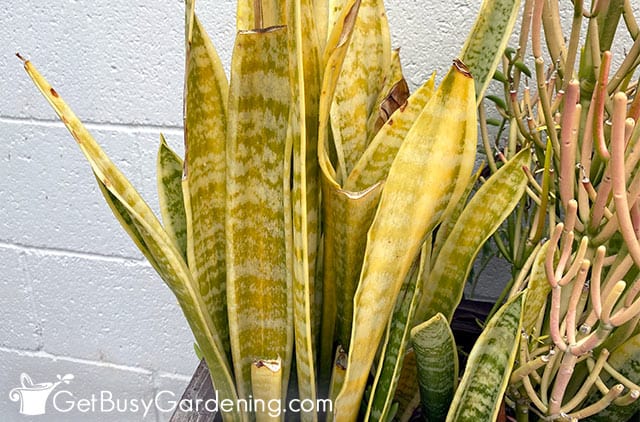See This Report about Snake Plant Leaves Turning Yellow
Wiki Article
Snake Plant Leaves Turning Yellow for Dummies
Table of ContentsThe Definitive Guide to Snake Plant Leaves Turning YellowHow Snake Plant Leaves Turning Yellow can Save You Time, Stress, and Money.Snake Plant Leaves Turning Yellow for BeginnersSnake Plant Leaves Turning Yellow - An OverviewThe Buzz on Snake Plant Leaves Turning Yellow
Below are seven factors your snake plant's leaves might be turning yellow and how to repair it. Several different plant problems can trigger yellow fallen leaves, or chlorosis. Chlorosis occurs when plants don't have the micronutrients they require to create chlorophyll, that makes foliage green and allows plants to convert sunshine right into food.Serpent plants are drought tolerant thanks to their delicious fallen leaves. Snake Plant Leaves Turning Yellow. These plants grow ideal in loosened, well-drained dirt that's allowed to dry completely between waterings and might only require water when monthly during wintertime. Overwatering can stop origins from absorbing wetness and nutrients that the plant requires and can even create root rot
A potbound plant can't soak up nutrients from the dirt. If your snake plant is jammed or outgrowing its pot, this may be the root cause of yellow fallen leaves. A periodic yellow leaf is entirely regular for a snake plant. As the plant ages, old fallen leaves yellow, pass away, and go down off as they're replaced with new ones.
See to it the plant has bright, indirect light and constantly cozy temperature levels, and water just once the dirt has actually totally dried out. Maintain an eye out for troubles and capture them early on to maintain your plant looking healthy and balanced and attractive.
How Snake Plant Leaves Turning Yellow can Save You Time, Stress, and Money.
If the fallen leaves on your serpent plant are getting soft, it's normally an indicator of way too much water. Snake plants shop water in their fallen leaves and if they're overwatered, the leaves can become soft and mushy. If you believe your serpent plant is being overwatered, allow the soil to dry completely prior to watering again.Yes, some yellowing is normal and to be anticipated on older fallen leaves, particularly as serpent plants age. If the plant is otherwise healthy and balanced and the fallen leaves are just gently yellowed then there is no cause for worry. Nevertheless, if the leaves are significantly yellowed or if there are other signs of distress after that it's ideal to act. Snake Plant Leaves Turning Yellow.

In basic, snake plants must be watered every one to two weeks. If you believe your serpent plant has been overwatered, the initial action is to stop watering it.
All about Snake Plant Leaves Turning Yellow

The snake plant is a great houseplant. The serpent plant is among those plants that are terrific for expanding inside in a terrarium, Snake plants can grow fairly big, but they additionally tend to be pretty low-maintenance. That doesn't suggest you should not take note of their appearance. Mean your at the bottom as a result of a lack helpful resources of nutrients or other problems.
When the dirt is overwatered, the plant cells absorb more water than they can save. Read right here to Leaves ended up being soggy and yellow as they take in extra water. Sagging serpent plant fallen leaves are brought on by soaked-up fallen leave cells shedding their suppleness. You might notice that your serpent plant will end up being black or brownish if the yellow spots are not remedied by remedying overwatering.
It is, therefore, most likely that your plant will detect yellow patches on its fallen leaves if you overfeed it with fertilizer during winter. The fallen leaves of serpent plants are additionally vulnerable to yellowing when overfed, especially if the roots are delicate. Repotting your yellowing, sprinkling only when the soil dries, and offering optimal temperature and light problems can conserve it.
How Snake Plant Leaves Turning Yellow can Save You Time, Stress, and Money.
To quit yellowing brought on by overwatering, stop watering the snake plant till the soil totally dries. Do not water greater than when a week. Water your serpent plant just when the leading 2 inches of soil really feel completely dry. While waiting on the water to drainpipe, water your serpent plant early in the early morning if your soil is slow-draining.Your can be removed by reducing off the yellow pointers - Snake Plant Leaves Turning Yellow. The trimmed fallen leaves ought to grow longer if they are watered correctly and have optimum light and temperature level conditions. It is essential to remember that the sharp ideas will certainly not grow back, causing them to attract attention from the rest of the leaves
At the same time, you can remove afflicted fallen leaves from the base of the plant. The essential message is to permit the serpent plant time to recover.
Scroll the write-up till the end to locate the remedy. Listen to this post below: The circumstance can be anticipated if his response you have had your snake plant for a long time, and yellowing takes place on the lower leaves as an all-natural aging cycle. Also, it is typical for the Sansevieria delegates transform yellow because of newbie blunders and when the plant is simply acquired from the nursery for repotting.
The Only Guide to Snake Plant Leaves Turning Yellow
A few of one of the most common reasons are listed here. Sansevierias like completely dry environments and prefer little water kept at a space of once or two times regular in summertime and regular monthly in wintertime. Yet when the water dosage gets out of control, your Sansevieria will endure from overwatering. One of the most usual issue provided by overwatering is root rot causing mushy roots and stems with a nasty scent.Report this wiki page